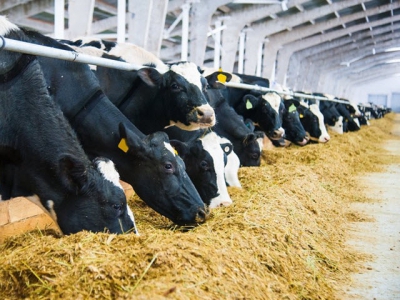Leading Egyptian dairy farm championing feed self-sufficiency

Autonomy in feed production for Egypt’s largest dairy business, Dina Farms, is one of the reported ambitions of its owner, Qalaa Holdings, a listed Egyptian investor in energy and infrastructure ventures in the Middle East and Africa.
The investment group revealed its plans for the dairy entity during a media tour of Dina Farms, with it outlining how it intends to invest a further US$24.09m into that business over the next three years.
Dina Farms is the dairy arm of Gozour, the name given to Qalaa Holdings’s regional multi-category integrated agrifoods subsidiary. The dairy business was originally established in 1987 with 300 Holstein Friesian heifers. It was acquired by Qalaa Holdings in 2007.
Today, it has expanded to become Egypt’s largest producer of fresh milk. By the end of this year, Dina Farms will comprise 17,194 heads of cattle and 8,529 milking cows. It is also set to see its milk and yogurt production capacity double, with a new yogurt production line set to be installed.
Beyond dairy manufacturing, Dina Farms is also involved in agricultural crop production, with the company also looking to widen its range of agricultural products.
Journalists heard that a key priority for the dairy business is the production of in-house animal feed in order to achieve 85% self-sufficiency by 2020. The Egyptian dairy company relies on a TMR cattle feeding approach. All its feed materials are of non-animal origin, with the rations containing grains and oilseeds such as corn and soy in addition to its own farm-cultivated forage, it said.
Qalaa Holdings’ investments in the agrifoods sector began in 2007, with the stated aimed of helping Egypt and the region overcome agricultural and food production challenges, namely climate change and the scarcity of natural resources, inefficient managerial expertise, the lack of economies of scale and insufficient funding. However, 2016 saw the group divest its entire holding in milk and juice subsidiaries, Enjoy and El-Aguizy.
Related news
 Canada: Cattle feed tools shed light on ingredient nutrition, value
Canada: Cattle feed tools shed light on ingredient nutrition, value A set of new, online tools is aimed at making information about nutritional components in cattle feed and the economic value of feed or feed ingredients more
 Yep dairy cows really love water beds
Yep dairy cows really love water beds When dairy cow water beds first appeared in the late 1990s, it was understood that it’s important for a cow to lie down, but mostly, cow beds were simply
 Heat stress alters mammary gland, dairy calf performance
Heat stress alters mammary gland, dairy calf performance Lack of cooling during summer may reduce milk yield of lactating cows by 20 lb. per day.